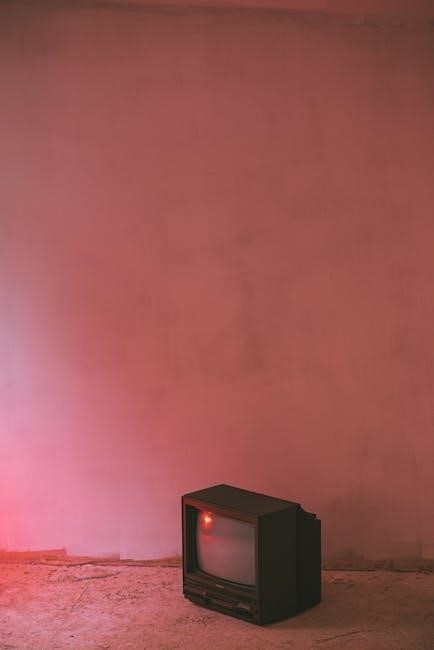The Piper Cherokee Service Manual is a comprehensive guide for maintaining PA-28 series aircraft, covering inspections, repairs, and compliance with aviation standards for safe operation.
1.1 Overview of the Piper Cherokee Aircraft Series
The Piper Cherokee series includes models PA-28-140, PA-28-150, PA-28-160, PA-28-180, PA-28-235, PA-28R-180, and PA-28R-200. These single-engine, four-seat aircraft are known for their reliability and versatility, suitable for training, recreation, and light transportation. The series offers varying engine power and configurations, catering to different pilot needs and preferences. This overview provides a foundation for understanding the aircraft’s design and operational capabilities, essential for effective maintenance and flight operations.
1.2 Purpose and Scope of the Service Manual
The Piper Cherokee Service Manual provides detailed instructions for maintaining and repairing PA-28 series aircraft. It covers routine inspections, scheduled maintenance, and compliance with aviation standards. The manual is designed for mechanics and owners to ensure continued airworthiness. It includes troubleshooting, repair procedures, and guidelines for handling hazardous materials. The scope encompasses all models, offering a comprehensive resource for safe and efficient aircraft operation and maintenance.
Models Covered in the Service Manual
The Piper Cherokee Service Manual covers models PA-28-140, PA-28-150, PA-28-160, PA-28-180, PA-28-235, PA-28R-180, and PA-28R-200, providing essential information for each to ensure compliance and optimal performance.
2.1 PA-28-140 Cherokee
The PA-28-140 Cherokee is a popular single-engine aircraft covered in the service manual, part number 753-586. It provides detailed instructions for inspections, maintenance, and repairs specific to this model. The manual includes guidelines for routine checks, scheduled maintenance tasks, and compliance with aviation standards. It is an essential resource for owners, mechanics, and pilots to ensure the aircraft remains airworthy and operates safely. Regular adherence to the manual’s procedures is crucial for optimal performance and longevity.
2.2 PA-28-150 Cherokee
The PA-28-150 Cherokee, part of the service manual (P/N 753-586), is a single-engine aircraft with a 150-hp engine. The manual provides detailed maintenance procedures, including inspections, repairs, and compliance with aviation standards. It covers routine tasks, scheduled maintenance, and airworthiness requirements. This model’s performance and durability make it a popular choice, and the manual ensures owners and mechanics can maintain it effectively for safe and reliable operation.
2.3 PA-28-160 Cherokee
The PA-28-160 Cherokee, covered in the service manual (P/N 753-586), features a 160-hp engine, offering enhanced performance. The manual details maintenance procedures, including inspections, repairs, and compliance with aviation standards. It ensures owners and mechanics can perform routine tasks and scheduled maintenance effectively, supporting the aircraft’s reliability and safety. This model’s capabilities make it a preferred choice, with the manual being an essential resource for its upkeep.
2.4 PA-28-180 Cherokee
The PA-28-180 Cherokee, covered in the service manual (P/N 753-586), is a popular model with a 180-hp engine, offering improved performance and versatility. The manual provides detailed maintenance procedures, including inspections, repairs, and compliance guidelines. It ensures owners and mechanics can maintain the aircraft’s airworthiness, addressing specific features of the PA-28-180. This model’s robust design and reliability make it a favorite, with the manual serving as an indispensable resource for its upkeep and safety.
2.5 PA-28-235 Cherokee
The PA-28-235 Cherokee, detailed in the service manual (P/N 753-586), features a powerful 235-hp engine, enhancing performance and payload capacity. The manual outlines specific maintenance requirements, including engine care and airframe inspections. Its robust design and higher power output make it suitable for demanding operations. The service manual ensures compliance with aviation standards, providing clear guidelines for inspections, repairs, and ongoing airworthiness, tailored to this model’s unique characteristics and operational needs.
2.6 PA-28R-180 Cherokee
The PA-28R-180 Cherokee, covered in the service manual (P/N 753-586), is a retractable-gear variant with a 180-hp engine, offering improved performance and efficiency. The manual provides detailed maintenance procedures, including gear system inspections and engine specifications. Its design enhances aerodynamic performance, making it suitable for both training and personal use. The service manual ensures adherence to aviation standards, with specific guidelines for inspections, repairs, and ongoing airworthiness for this model.
2.7 PA-28R-200 Cherokee
The PA-28R-200 Cherokee, covered in the service manual (P/N 753-586), features a 200-hp engine and retractable landing gear, offering enhanced performance and efficiency. The manual provides detailed maintenance procedures, including gear system inspections and engine specifications. Designed for improved aerodynamic performance, this model is ideal for both training and personal use. The service manual ensures compliance with aviation standards, with specific guidelines for inspections, repairs, and ongoing airworthiness for this variant.
Structure and Organization of the Service Manual
The service manual is organized into sections, including an index guide and revision status, ensuring easy access to maintenance procedures and updates for all Cherokee models.
3.1 Section Index Guide
3.2 Revision Status and Updates
The Piper Cherokee Service Manual’s revision status and updates are meticulously tracked to ensure compliance with aviation standards. Revisions are detailed in the manual, with part number 753-586, last updated on January 31, 2008. Updates are incorporated through Aerofiche cards, ensuring all maintenance procedures remain current and accurate. Users are advised to consult the Customer Service Information Aerofiche for the most recent revision dates and changes, ensuring all maintenance procedures remain current and accurate for safe operations.
Maintenance Schedules and Procedures
The manual outlines routine inspections and scheduled maintenance tasks to ensure compliance with aviation standards, promoting aircraft safety and longevity through systematic upkeep procedures.
4.1 Routine Inspections and Checks
The Piper Cherokee Service Manual details routine inspections and checks to ensure aircraft airworthiness. These include pre-flight, post-flight, and periodic inspections of critical systems and components. Regular checks cover control surfaces, landing gear, tires, brakes, and fluid levels. Additionally, the manual specifies inspection intervals for engine components, propellers, and avionics to maintain safety and performance. Adhering to these procedures ensures compliance with aviation standards and prolongs aircraft lifespan.
4.2 Scheduled Maintenance Tasks
The Piper Cherokee Service Manual outlines scheduled maintenance tasks to ensure optimal aircraft performance. These include oil changes, lubrication, and filter replacements, as well as tire, brake, and propeller inspections. Tasks are detailed for models PA-28-140 to PA-28R-200, with specific intervals to follow. Compliance with these schedules ensures adherence to FAA and EASA standards, maintaining safety and airworthiness.
Airworthiness Directives and Compliance
The manual ensures adherence to FAA and EASA directives, outlining mandatory inspections and modifications to maintain airworthiness. Compliance with these standards is critical for safe operation.
5.1 Mandatory Modifications and Inspections
This section outlines mandatory modifications and inspections required to maintain airworthiness. It includes specific directives for structural integrity, system upgrades, and periodic checks. Compliance ensures safety and regulatory adherence, with detailed procedures for each modification. Reference part numbers and inspection intervals are provided to guide maintenance professionals. Adhering to these requirements is critical for operational safety and avoiding potential failures. The manual emphasizes timely implementation of all mandated changes.
5.2 Compliance with Aviation Standards
Compliance with aviation standards ensures the Piper Cherokee meets regulatory requirements for safe operation. The manual aligns with FAA and EASA guidelines, detailing specifications for design, maintenance, and operation. Adherence to these standards is mandatory, covering areas like airworthiness, performance, and safety systems. Proper documentation and record-keeping are emphasized to demonstrate compliance. Failure to meet these standards can result in operational restrictions or legal consequences, making adherence critical for both safety and regulatory approval.
Troubleshooting and Diagnostic Procedures
The manual provides detailed troubleshooting guides for common issues, offering solutions and diagnostic tools to identify and resolve problems efficiently, ensuring optimal aircraft performance and safety.
6.1 Common Issues and Solutions
The Piper Cherokee Service Manual addresses common issues such as engine performance problems, landing gear malfunctions, and avionics glitches. Solutions include routine inspections, lubrication of moving parts, and system checks. The manual provides step-by-step guides for resolving these issues, ensuring aircraft safety and reliability. Troubleshooting charts and diagnostic tools are also included to help mechanics identify and fix problems efficiently.
6.2 Diagnostic Tools and Techniques
The Piper Cherokee Service Manual outlines diagnostic tools and techniques for effective troubleshooting. These include visual inspections, system tests, and specialized equipment like multimeters and compression testers. The manual emphasizes the use of manufacturer-recommended tools to ensure accuracy. Detailed flowcharts and fault isolation procedures guide technicians through identifying and resolving issues efficiently, minimizing downtime and ensuring compliance with safety standards.
Repair and Overhaul Procedures
The Piper Cherokee Service Manual provides detailed repair and overhaul procedures for engines and airframes, ensuring compliance with manufacturer specifications and safety standards.
7.1 Engine Repair and Overhaul
The Piper Cherokee Service Manual provides detailed engine repair and overhaul procedures, including disassembly, inspection, and reassembly guidelines; It specifies torque values, tolerances, and approved lubricants, ensuring compliance with manufacturer standards. The manual emphasizes proper handling of engine components and adherence to safety protocols to maintain airworthiness. Oil recommendations are highlighted, noting that engine manufacturers do not endorse specific brands, focusing instead on performance specifications.
7.2 Airframe and System Repairs
The Piper Cherokee Service Manual details airframe and system repair procedures, including inspection guidelines for structural components and instructions for replacing worn or damaged parts. It emphasizes adherence to safety standards and manufacturer specifications to ensure aircraft integrity. The manual also covers system-specific maintenance, such as landing gear and avionics, providing clear steps for troubleshooting and restoring functionality. Compliance with aviation regulations is stressed throughout.
Service Manual Revisions and Updates
The manual includes revision history, ensuring compliance with safety standards; Updates are detailed in Aerofiche cards, with part number 753-586, last revised on January 31, 2008.
8.1 Revision History and Changes
The Piper Cherokee Service Manual’s revision history is detailed in Aerofiche cards, with the latest update dated January 31, 2008 (Part Number 753-586). Changes include technical updates, safety compliance, and clarifications. Users are advised to consult the Customer Service Information Aerofiche for the most current revision dates and updates. This ensures adherence to the latest aviation standards and safety protocols.
8.2 How to Access the Latest Updates
To access the latest updates for the Piper Cherokee Service Manual, visit official sources like ManualsLib or Piper Aircraft Corporation’s website. The manual is available as a PDF (Part Number 753-586) and can be downloaded for free. Ensure to check the revision history and dates through the Customer Service Information Aerofiche (P/N 1753-755) for the most current updates and compliance with aviation standards.
Safety Precautions and Guidelines
Adhere to general safety practices, handle hazardous materials carefully, and follow specific warnings to ensure safe maintenance and operation of the Piper Cherokee aircraft.
9.1 General Safety Practices
Always wear protective gear, ensure proper tool usage, and follow manufacturer guidelines. Maintain a clean workspace to prevent accidents. Use approved materials and adhere to safety protocols during inspections and repairs. Ensure all systems are grounded before servicing. Follow proper lockout/tagout procedures for fuel, electrical, and hydraulic systems. Never bypass safety devices or skip critical checks. Consult the manual for specific precautions related to each task to ensure safe and effective maintenance.
9.2 Hazardous Materials and Handling
Identify and handle hazardous materials like fuels, oils, and chemicals with care. Use protective equipment and follow proper storage and disposal procedures. Ensure compliance with environmental regulations and safety standards. Refer to the manual for specific guidelines on handling hazardous substances, including emergency procedures and spill containment. Always follow recommended safety practices to minimize risks during maintenance and servicing of the aircraft.
Compliance with Aviation Regulations
Ensure adherence to aviation authority regulations for airworthiness, safety, and operational standards. Follow guidelines for inspections, modifications, and documentation to maintain compliance and legal flight status.
10.1 FAA and EASA Compliance
Adherence to FAA and EASA regulations is critical for Piper Cherokee aircraft. The service manual ensures compliance with airworthiness directives, mandatory inspections, and operational standards. Specific guidelines for PA-28 models cover inspections, modifications, and documentation to meet regulatory requirements. Compliance ensures legal flight operations and safety standards are maintained. Non-compliance can result in grounding or legal action, emphasizing the importance of following these regulations strictly.
10.2 Record-Keeping and Documentation
Accurate record-keeping is essential for maintaining airworthiness and compliance. The service manual requires detailed documentation of all inspections, maintenance, and repairs. Logs must include dates, procedures performed, and technician signatures. Proper documentation ensures traceability and compliance with FAA and EASA regulations. Incomplete or inaccurate records can lead to legal issues or aircraft grounding. Regular audits and digital backups are recommended to maintain integrity and accessibility of critical maintenance data.
Downloading and Accessing the Service Manual
The Piper Cherokee Service Manual is available as a PDF download from sources like ManualsLib. Part Number 753-586, dated January 31, 2008, ensures authenticity and accessibility.
11.1 Sources for the Service Manual
The Piper Cherokee Service Manual is available through ManualsLib, Piper Aircraft Corporation, and authorized aviation suppliers. Part Number 753-586 ensures authenticity. It can be downloaded as a PDF from trusted sources like ManualsLib or Piper’s official website. The manual covers models PA-28-140 to PA-28R-200, providing detailed maintenance instructions. Free downloads are accessible, ensuring easy access for owners and mechanics to maintain airworthiness and perform repairs effectively.
11.2 Instructions for PDF Access
To access the Piper Cherokee Service Manual as a PDF, visit trusted sources like ManualsLib or Piper Aircraft Corporation’s official website; Search using the part number (e.g., 753-586) to locate the document. Download the PDF file and ensure you have a compatible reader installed. The manual is free to download, offering easy access to maintenance instructions, diagrams, and technical specifications for all covered Cherokee models.
Landing Gear Maintenance and Inspection
Regular inspections and lubrication of landing gear components are essential. Ensure all parts are in good condition and comply with the service manual’s guidelines for safe operation.
12.1 Inspection Procedures
The Piper Cherokee Service Manual outlines detailed inspection procedures for the landing gear, including visual checks for wear and damage. Regular lubrication of moving parts and torque checks on bolts are essential. The manual provides step-by-step guidance to ensure compliance with safety standards and maintain airworthiness. Adhering to these procedures is crucial for safe and reliable aircraft operation.
12.2 Repair and Replacement Guidelines
The Piper Cherokee Service Manual provides detailed repair and replacement guidelines for landing gear components. It specifies approved materials and tools for structural repairs. Replacement parts must meet OEM standards, and torque specifications must be followed. The manual also outlines procedures for lubricating moving parts and inspecting for wear. Adherence to these guidelines ensures safety and compliance with airworthiness standards, maintaining the aircraft’s reliability and performance.
Engine Maintenance Recommendations
The Piper Cherokee Service Manual recommends regular oil changes, adherence to fluid specifications, and monitoring of engine performance to ensure optimal functionality and longevity of the aircraft engine.
13.1 Oil and Fluid Specifications
The Piper Cherokee Service Manual specifies approved oils and lubricants for engine maintenance, ensuring compliance with aviation standards. It recommends using oils that meet SAE standards and are suitable for the aircraft’s operating conditions. Fluid capacity and specifications are detailed to maintain optimal engine performance and longevity. Adherence to these guidelines is critical for ensuring the engine operates efficiently and safely under various flight conditions.
13.2 Engine Performance Monitoring
The Piper Cherokee Service Manual emphasizes regular engine performance monitoring to ensure optimal operation. Pilots should check oil levels, fuel flow, and temperature during pre-flight and flight. Monitoring engine RPM, manifold pressure, and fuel consumption helps identify potential issues early. The manual also outlines diagnostic tools and techniques to assess engine health, ensuring compliance with aviation standards and manufacturer recommendations for safe and efficient aircraft performance.
Oil and Fluid Recommendations
Use approved oils and lubricants as specified in the manual for optimal engine performance. Regularly check fluid capacity and adhere to aviation standards and manufacturer recommendations.
14.1 Approved Oils and Lubricants
The Piper Cherokee Service Manual specifies approved oils and lubricants for engine performance, meeting aviation standards. These are suitable for various operating conditions and ensure optimal engine longevity. The manual does not endorse specific brands but provides detailed specifications for oil viscosity and types. Always refer to the latest revision of the manual for updated recommendations and compliance with manufacturer guidelines.
14.2 Fluid Capacity and Specifications
The Piper Cherokee Service Manual provides detailed fluid capacity and specifications for oils, fuels, and hydraulic fluids. It outlines the exact quantities required for engine, gearbox, and other systems. Compliance with these specifications ensures optimal performance and safety. The manual includes charts and tables for quick reference, helping maintainers adhere to recommended levels and avoid overfilling or underfilling, which could compromise aircraft functionality and longevity.
The Piper Cherokee Service Manual is an essential resource for maintaining the airworthiness, safety, and performance of PA-28 series aircraft. It provides detailed guidance for owners, mechanics, and pilots, ensuring compliance with aviation standards. Regular updates and clear instructions make it a reliable reference for troubleshooting, repairs, and routine maintenance, fostering confidence in the aircraft’s continued operational excellence and longevity.















































































